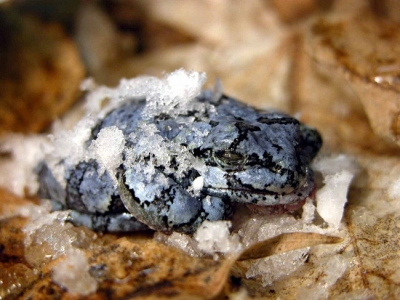
Did you know wood frogs can freeze without actually dying? When temperatures dip to 0 degrees Celsius, ice starts to form on their skin. Two-third of their body water becomes ice. As a wood frog starts freezing, its heart continues to function to distribute glucose (a cryoprotectant) throughout its body to promote freeze tolerance. The heart slows down and stops with the completion of ice formation. The wood frog survives frigid winters like this, and when spring arrives and temperatures warm, it thaws out and hops away.
Most frogs survive northern winters by hibernating deep under water, in ponds, lakes and streams—they are cold and dormant but their body temperature never falls below freezing.
Wood frogs have a different strategy. They hibernate by nestling down into the leafy litter on the forest floor. The leaves, duff and overlying snow give some insulation from extreme cold, but the frogs are not protected from subfreezing temperatures as they would be if they chose the underwater strategy.
Researchers have found that wood frogs spend the winter frozen! This amazing strategy allows wood frogs to become active very early in spring, because the land thaws and warms more quickly than the ice-covered lakes The newly active frogs can mate and lay eggs in small ponds and even in melt water pools that dry up by midsummer. By contrast, frogs that hibernate underwater take longer to become active, so they must breed later. These frogs need permanent water that won’t dry out.
Picture Credit : Google



